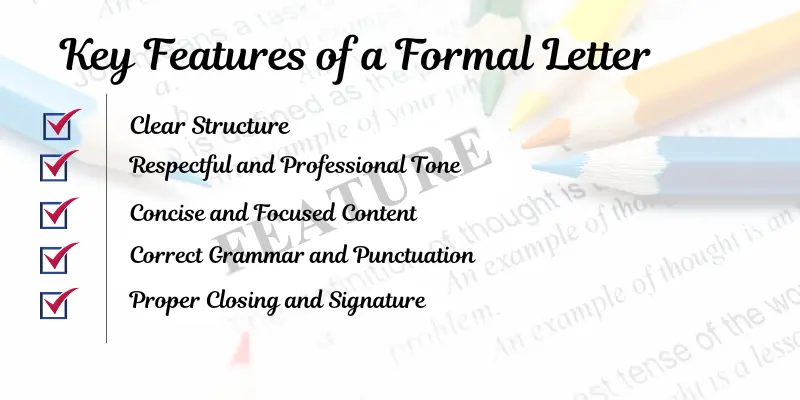What is a Formal Letter? Key Features, Uses, and Importance Explained
Published: 12 Nov 2024
Welcome to letter format!
The first time I had to write a formal letter was in college when I needed to reach out to my professor. It was then that I realized how different it is from sending a casual text message. Just as you are recognized by your clothes and mannerisms in a gathering, a formal letter reflects your writing skills and professionalism.
Think of writing a formal letter like preparing an invitation card for an important guest. You want that first impression to be perfect—clear and well-crafted.
As the famous writer Ernest Hemingway said,
“There is nothing to writing. All you do is sit down at the typewriter and bleed.”Ernest Hemingway
This emphasizes the effort and care that go into crafting a powerful message.
But don’t worry! In this article, we’ll cover everything you need to know about formal letters. We’ll explore what a formal letter is and why it’s important to write one. You’ll learn about the Uses and Key Features of Formal Letters, types of formal letters, and Pros and Cons of writing a formal letter
So, read on and improve your letter-writing skills. After all, good communication skills are incredibly helpful in your career and personal relationships!
2. What is a Formal Letter?
A formal letter is a type of writing used for important messages. People write it in jobs, schools, or official situations. This letter serves as a record. You might use it to apply for a job or to make a complaint.

Think of a formal letter as a bridge. It connects you to the reader. Just like a clear path helps you walk, a good formal letter helps your message come across clearly.
3. Why is Writing a Formal Letter Important?
Writing a formal letter is very important in professional situations. It helps you communicate clearly and respectfully. When you write formally, you show that you are serious and professional.

Formal letters are key for things like job applications and official requests. For example, a good cover letter can catch an employer’s attention. It shows your skills and why you are a good fit for the job.
Formal letters are also necessary for making requests. Whether you want time off from work or need to talk to a government office, a formal letter is often the best way to do it.
3. Key Features of a Formal Letter
Formal letters have a few essential characteristics that make them different from other forms of communication. These key features ensure the letter remains professional and to the point.

Let’s look at five key features of a formal letter:
- Clear Structure
A formal letter has a specific format, including the sender’s address, the recipient’s address, a greeting, the body, and a closing. This structure helps keep the letter organized and easy to understand. - Respectful and Professional Tone
The language used is always polite, formal, and neutral. There’s no place for casual language or slang. A formal letter communicates respect and professionalism, no matter the topic. - Concise and Focused Content
Formal letters get straight to the point. The body is always direct and clear, focusing only on the necessary details. This ensures that the reader doesn’t have to search for the main message. - Correct Grammar and Punctuation
Formal letters maintain a high standard of grammar and punctuation. Using proper sentence structure and punctuation reflects the seriousness of the communication. - Proper Closing and Signature
A formal letter ends with a respectful closing phrase such as “Yours sincerely” or “Best regards,” followed by the sender’s signature. This formal ending helps conclude the letter with the right tone.
4. Common Uses of a Formal Letter
Formal letters are used in many areas of life, especially where clear, respectful, and professional communication is required.

Here are some common situations where formal letters are typically used:
- Job Applications
When applying for a job, a formal letter (commonly known as a cover letter) is required. This letter introduces you to the employer, explains why you’re applying for the job, and highlights your qualifications. - Business Correspondence
In the business world, formal letters are often used for a variety of purposes, such as communicating with clients, partners, or suppliers, making requests, and confirming agreements or contracts. - Requesting Information
Formal letters are often written when a person needs information or clarification on a specific matter. For example, writing to a university to request details about a course or writing to a company to inquire about their services. - Filing Complaints or Expressing Concerns
When dealing with a problem or issue that needs to be addressed, formal letters provide a structured way to express complaints or concerns. This could be a complaint to a service provider, a government agency, or even a workplace issue. - Thank-you or Appreciation Letters
Formal letters are also used to express gratitude. These letters could be sent after an interview, a meeting, or as a way to thank someone for their help, support, or a gift.
These are just a few examples of how formal letters are used in different contexts. If you’re interested in reading more about different types of letters, you can check out our article on Types of Letters.
5. Advantages of Writing a Formal Letter

Writing a formal letter comes with several benefits that make it an effective tool for professional communication:
| Pros of Writing a Formal Letter |
|---|
|
6. Disadvantages of Writing Formal Letters

Despite their advantages, formal letters do have a few downsides to consider:
| Cons Of Writing a Formal Letter |
|---|
|
(FAQs) About Formal Letter Writing
Formal letter writing can be challenging for beginners or those unfamiliar with the structure and tone. Below, we address some of the most common questions related to formal letters to help you understand their importance and improve your writing skills.
The main purpose of a formal letter is to convey important information or make a request in a professional and respectful manner. This type of letter is used in various contexts, such as business communication, job applications, and official requests.
A formal letter typically includes the sender’s address, the date, the recipient’s address, a formal greeting, the body, a closing phrase, and the sender’s signature. These elements ensure clarity and professionalism in the communication.
A formal letter should begin with an appropriate greeting, such as “Dear [Recipient’s Name]” or “To Whom It May Concern” if the recipient is unknown. This sets a respectful and professional tone for the rest of the letter.
The tone of a formal letter should be polite, neutral, and professional. Avoid casual or slang language and ensure your message is clear and direct while maintaining respect.
Correct grammar and punctuation are vital in a formal letter because they reflect your attention to detail and professionalism. Errors can make your letter appear careless and reduce its credibility.
It is best to avoid contractions (e.g., “can’t,” “won’t”) in a formal letter. Using full forms like “cannot” and “will not” helps maintain a more formal tone.
Common types of formal letters include job application letters, business correspondence, complaint letters, letters of request, and recommendation letters. Each type serves a specific purpose and follows a particular format.
A formal letter should be concise and to the point. Ideally, it should be no longer than one page. Make sure to include all relevant details without adding unnecessary information.
A formal letter is used for professional or official purposes and follows a strict format with a respectful tone. An informal letter is more casual and personal, used for communication with friends or family, and does not have a specific structure.
A formal letter should end with a closing phrase such as “Yours sincerely” (when you know the recipient’s name) or “Yours faithfully” (when the recipient is unknown). Follow this with your signature and printed name.
Conclusion
Understanding what is a formal letter and how to write one is an important skill that can make a big difference in your communication. Here’s what we covered:
- Formal letters are essential for professional and official communication.
- They show respect, professionalism, and clarity.
- Key features include a clear structure, polite tone, focused content, correct grammar, and proper closing.
- Knowing the pros and cons helps you use them effectively when needed.
By following these guidelines, you can write formal letters that make a strong impression and help you succeed in different situations.
We’d love to hear from you! What did you learn from this article? Share your thoughts in the comments below. And don’t forget to follow us on social media for updates and tips on effective communication!

- Be Respectful
- Stay Relevant
- Stay Positive
- True Feedback
- Encourage Discussion
- Avoid Spamming
- No Fake News
- Don't Copy-Paste
- No Personal Attacks

- Be Respectful
- Stay Relevant
- Stay Positive
- True Feedback
- Encourage Discussion
- Avoid Spamming
- No Fake News
- Don't Copy-Paste
- No Personal Attacks








